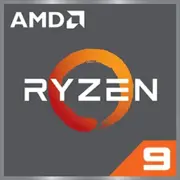AMD Ryzen 9 7950X3D

AMD Ryzen 9 7950X3D: A Guide to the Flagship Processor for Gamers and Professionals
Key Features: Architecture and Innovations
The AMD Ryzen 9 7950X3D, released in 2023, is the company's response to enthusiasts demanding maximum performance in gaming and professional tasks. Based on the Zen 4 architecture (codename Raphael), this chip is manufactured using TSMC's 5-nanometer FinFET technology, providing high energy efficiency.
Key Features:
- 16 cores and 32 threads — multi-threaded power for rendering, streaming, and scientific computation.
- 3D V-Cache — an additional 64 MB of L3 cache stacked on top of the standard 64 MB, resulting in a record-breaking 128 MB L3. This enhances performance in games and applications sensitive to latency (e.g., Unreal Engine 5).
- Integrated Radeon graphics — a basic iGPU with 2 cores, sufficient for office tasks or backup display output.
- TDP of 120W — moderate power consumption for this level of performance.
Performance:
In Geekbench 6 testing, the processor scores 2912 points in single-core and 19642 in multi-core modes. For instance, in the game Cyberpunk 2077 at 1440p resolution with max settings, the chip provides stable 120+ FPS when paired with an RTX 4080, while in Blender, rendering a BMW scene is completed 15% faster compared to the Ryzen 9 5950X.
Compatible Motherboards: AM5 Socket and Chipsets
The Ryzen 9 7950X3D uses the AM5 socket, requiring a platform upgrade for owners of AM4 systems. Supported chipsets include:
- X670E/X670 — top choice for overclocking and PCIe 5.0 (both for GPUs and NVMe). Examples include the ASUS ROG Crosshair X670E Hero (supports DDR5-6400, 14+2 power phases).
- B650 — an optimal option for the majority of users. Boards like the MSI MPG B650 Carbon offer PCIe 5.0 for storage but are limited to PCIe 4.0 for graphics cards.
Selection Features:
- Be sure to update the BIOS before installing the processor. For instance, early versions of BIOS for ASUS boards may not recognize the 7950X3D.
- For overclocking, choose boards with robust VRM (at least 12+2 phases).
Supported Memory: DDR5 Only
The processor operates exclusively with DDR5, which speeds up task execution but increases the overall cost of the build. Recommended specifications include:
- 6000 MHz frequency — optimal for Zen 4 (best price/performance ratio).
- EXPO profiles — analogous to Intel's XMP, automatically adjusting timings.
For example, the G.Skill Trident Z5 Neo 32GB (6000 MHz, CL30) kit offers an 8-12% performance boost in games compared to DDR5-4800.
Power Supplies: Power Calculation
With a TDP of 120W, the Ryzen 9 7950X3D is less power-hungry than its Intel competitors, but the choice of PSU depends on the graphics card:
- For systems with RTX 4070 Ti / RX 7900 XT, a 750W PSU is sufficient (e.g., Corsair RM750e).
- With an RTX 4090 or overclocking — 850-1000W (Seasonic PRIME TX-1000).
Tips:
- Use power supplies with an 80 Plus Gold certification or higher.
- Don’t skimp on cables: modular PSUs simplify assembly and improve airflow.
Pros and Cons of the Ryzen 9 7950X3D
Advantages:
- Best-in-class gaming performance thanks to 3D V-Cache.
- Energy efficiency: even under load, the chip consumes less than the Intel Core i9-13900K.
- Support for PCIe 5.0 and DDR5 — a good future-proofing option.
Disadvantages:
- High price (starting from $700).
- No compatibility with DDR4.
- Not all games are optimized for 3D V-Cache — sometimes, the FPS gain is minimal (Starfield showed a +5% increase over the 7950X).
Use Cases: Where the Potential Shines
1. Gaming: Maximum FPS in CS2, Microsoft Flight Simulator, Cyberpunk 2077.
2. Work Tasks: 3D rendering (Blender, Maya), code compilation, video processing in DaVinci Resolve.
3. Streaming: Simultaneous gaming and broadcasting in OBS without quality loss.
Example: When editing 8K video in Premiere Pro, rendering on the 7950X3D is completed 25% faster than on the Ryzen 9 5900X.
Comparison with Competitors: Intel vs AMD
The main rival is the Intel Core i9-13900K (24 cores, 32 threads).
- In gaming: The 7950X3D outperforms in most DX12 titles (up to +20% in Shadow of the Tomb Raider), but lags in single-threaded scenarios (e.g., Stellaris).
- Multi-threaded tasks: Thanks to the 3D V-Cache, AMD leads in rendering, but Intel is faster in data compression (7-Zip).
- Power consumption: Under load, the 13900K consumes up to 250W compared to 142W for the 7950X3D.
Practical Assembly Tips
1. Cooling: Use an AIO cooler (e.g., NZXT Kraken X63) or a top-tier air cooler (Noctua NH-D15). Without adequate cooling, the chip throttles at 95°C.
2. Case: At least 3 intake fans. A good option is the Lian Li Lancool III.
3. Thermal Paste: Arctic MX-6 or Thermal Grizzly Kryonaut will lower temperatures by 3-5°C.
4. BIOS Settings: Enable EXPO for memory and Precision Boost Overdrive for automatic overclocking.
Final Takeaway: Who Should Consider the Ryzen 9 7950X3D
This processor is ideal for:
- Gamers seeking maximum FPS at 4K.
- Professionals working with 3D, video, and virtualization.
- Enthusiasts who value energy efficiency and cutting-edge technology.
It may not be suitable for those looking for a budget solution or planning to use DDR4. If your tasks do not demand 16 cores, consider the Ryzen 7 7800X3D — it’s cheaper and nearly as good for gaming.
The Ryzen 9 7950X3D is a blend of innovation and power, perfect for those who refuse to compromise.
Basic
CPU Specifications
Memory Specifications
GPU Specifications
Miscellaneous
Benchmarks
Compared to Other CPU
Share in social media
Or Link To Us
<a href="https://cputronic.com/cpu/amd-ryzen-9-7950x3d" target="_blank">AMD Ryzen 9 7950X3D</a>